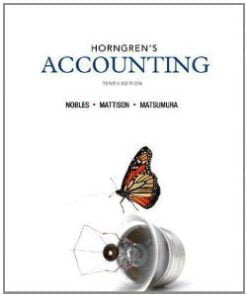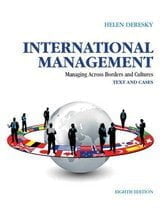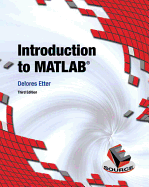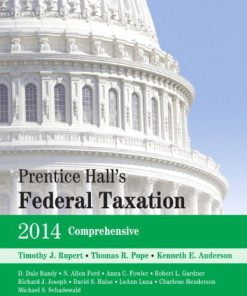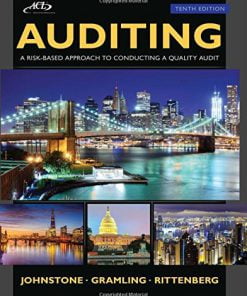Solution Manual for Organizational Behavior: Bridging Science and Practice Version 3.0
$55.00 Original price was: $55.00.$29.99Current price is: $29.99.
Solution Manual for Organizational Behavior: Bridging Science and Practice Version 3.0
This is completed downloadable of Solution Manual for Organizational Behavior: Bridging Science and Practice Version 3.0

Product Details:
- ISBN-10 : 1453391975
- ISBN-13 : 978-1453391976
- Author: Talya Buer (Author), Berrin Erdogan (Author)
When purchased from FlatWorld (the publisher), this Color Print Textbook includes Online Access, Quizzes, Flashcards and Homework (if professor uses Homework system). Online textbook is accessible. By expertly weaving together the equally important strands of management theory and practice, Organizational Behavior: Bridging Science and Practice provides students with the key vocabulary, conceptual frameworks, and critical thinking skills necessary to diagnose work-based interactions, ask pertinent questions, evaluate gathered data, and act in an effective and ethical manner regardless of situational characteristics.
Table of Content:
- Chapter 1: Organizational Behavior
- 1.1: Employee Engagement in Organizational Change Toward B Corp Status: The Case of Townshend’s Te
- 1.2: Understanding Organizational Behavior
- About This Book
- What Is Organizational Behavior?
- Why Organizational Behavior Matters
- Adding to Your OB Toolbox
- Isn’t OB Just Common Sense?
- 1.3: Learning and Retention
- Learning and Retaining Information
- Learning Style Preferences
- Internships as Learning Opportunities
- 1.4: Organizational Behavior Research Methods
- Research Concepts, Tools, and Approaches
- Surveys
- Field Studies
- Laboratory Studies
- Case Studies
- Meta-Analysis
- Machine Learning
- Measurement Issues in OB
- Analytics
- 1.5: Trends Influencing Organizational Behavior
- Challenges and Opportunities
- Ethical Challenges
- Online Data Privacy Concerns
- Lack of Employee Engagement
- Technology: Processing Power, Billions of Emails, and Automation
- Uneven Information Quality
- Sustainability and Green Business Practices
- Aging Workforce
- The Global Marketplace for Staffing
- 1.6: Maintaining a Customer Service Culture: The Case of Les Schwab Tires
- 1.7: Conclusion
- 1.8: Exercises
- Endnotes
- Chapter 2: Diversity in the Workplace
- 2.1: Equality as a Core Value: The Case of Salesforce.com
- 2.2: Demographic Diversity
- Benefits of Diversity and Inclusion
- Higher Creativity in Decision Making
- Better Understanding and Service of Customers
- More Satisfied Workforce
- Higher Stock Prices
- Lower Litigation Expenses
- Higher Company Performance
- Challenges of Diversity
- Similarity-Attraction Phenomenon
- Faultlines
- Stereotypes and Unconscious Biases
- Specific Diversity Issues
- Gender Diversity in the Workplace
- Earnings Gap
- Glass Ceiling
- Sexual Harassment
- Race Diversity in the Workplace
- Age Diversity in the Workplace
- Religious Diversity in the Workplace
- Employees with Disabilities in the Workplace
- Sexual Orientation Diversity in the Workplace
- Suggestions for Managing Demographic Diversity
- Build an Inclusive Culture
- Make Managers Accountable for Diversity
- Diversity Training Programs
- Review Recruitment Practices
- Affirmative Action Programs
- 2.3: Cultural Diversity
- Individualism-Collectivism
- Power Distance
- Uncertainty Avoidance
- Aggressive-Nurturing (Masculinity–Femininity)
- Suggestions for Managing Cultural Diversity
- Help Employees Build Cultural Intelligence
- Avoid Ethnocentrism
- Listen to Locals
- Recognize That Culture Changes
- Do Not Always Assume That Culture Is the Problem
- 2.4: The Role of Ethics and National Culture
- Diversity and Ethics
- Diversity Around the Globe
- 2.5: Managing Diversity for Success: The Case of IBM
- 2.6: Conclusion
- 2.7: Exercises
- Endnotes
- Chapter 3: Understanding People at Work: Individual Differences and Perception
- 3.1: Hiring for Match: The Case of Netflix
- 3.2: The Interactionist Perspective: The Role of Fit
- 3.3: Individual Differences: Values and Personality
- Values
- Personality
- Big Five Personality Traits
- Myers-Briggs Type Indicator
- Positive and Negative Affectivity
- Self-Monitoring
- Proactive Personality
- Self-Esteem
- Self-Efficacy
- Locus of Control
- Personality Testing in Employee Selection
- 3.4: Perception
- Visual Perception
- Self-Perception
- Social Perception
- Attributions
- 3.5: The Role of Ethics and National Culture
- Individual Differences and Ethics
- Individual Differences Around the Globe
- 3.6: Using Big Data to Match Applicants to Jobs: The Case of Cornerstone OnDemand
- 3.7: Conclusion
- 3.8: Exercises
- Endnotes
- Chapter 4: Individual Attitudes and Behaviors
- 4.1: Fostering Positive Job Attitudes and Professional Development: The Case of Enterprise Holding
- 4.2: Work Attitudes
- What Causes Positive Work Attitudes?
- Personality
- Person–Environment Fit
- Job Characteristics
- Psychological Contract
- Organizational Justice
- Relationships at Work
- Stress
- Work-Life Balance
- Consequences of Positive Work Attitudes
- Assessing Work Attitudes in the Workplace
- 4.3: Work Behaviors
- Job Performance
- What Are the Major Predictors of Job Performance?
- Organizational Citizenship Behaviors
- Absenteeism
- Turnover
- 4.4: The Role of Ethics and National Culture
- Job Attitudes, Behaviors, and Ethics
- Job Attitudes Around the Globe
- 4.5: People Come First: The Case of SAS
- 4.6: Conclusion
- 4.7: Exercises
- Endnotes
- Chapter 5: Theories of Motivation
- 5.1: Creating Happiness Through Motivation: The Case of The Walt Disney Company
- 5.2: Need-Based Theories of Motivation
- Maslow’s Hierarchy of Needs
- ERG Theory
- Two-Factor Theory
- Acquired-Needs Theory
- 5.3: Process-Based Theories
- Equity Theory
- What Are Inputs and Outcomes?
- Who Is the Referent?
- Reactions to Unfairness
- Overpayment Inequity
- Individual Differences in Reactions to Inequity
- Fairness Beyond Equity: Procedural and Interactional Justice
- Expectancy Theory
- Influencing Expectancy Perceptions
- Influencing Instrumentality Perceptions
- Influencing Valence
- Reinforcement Theory
- Reinforcement Interventions
- Reinforcement Schedules
- 5.4: The Role of Ethics and National Culture
- Motivation and Ethics
- Motivation Around the Globe
- 5.5: A Motivating Place to Work: The Case of Zappos
- 5.6: Conclusion
- 5.7: Exercises
- Endnotes
- Chapter 6: Designing a Motivating Work Environment
- 6.1: Retail with a Purpose: The Case of REI
- 6.2: Motivating Employees Through Job Design
- Importance of Job Design
- Scientific Management and Job Specialization
- Alternatives to Job Specialization
- Job Characteristics Model
- Empowerment
- 6.3: Motivating Employees Through Goal Setting
- Goal-Setting Theory
- Setting SMART Goals
- Specific and Measurable
- Aggressive
- Realistic
- Time-Bound
- Why Do SMART Goals Motivate?
- When Are Goals More Effective?
- Feedback
- Ability
- Goal Commitment
- Are There Downsides to Goal Setting?
- Ensuring Goal Alignment Through Management by Objectives (MBO)
- 6.4: Motivating Employees Through Performance Appraisals
- What Is Performance Management?
- What Is the Purpose of a Performance Appraisal?
- Who Is the Rater?
- What Makes an Effective Appraisal System?
- Absolute Rating versus Relative Ranking Appraisals
- Conducting the Appraisal Meeting
- Managing Potential Bias in Performance Appraisals
- Liking
- Leniency
- Stereotypes
- 6.5: Motivating Employees Through Performance Incentives
- Performance Incentives
- Piece Rate Systems
- Individual Bonuses
- Merit Pay
- Sales Commissions
- Employee Recognition Awards
- Team Bonuses
- Gainsharing
- Profit Sharing
- Stock Options
- 6.6: The Role of Ethics and National Culture
- Designing a Motivating Work Environment and Ethics
- Designing a Motivating Work Environment Around the Globe
- 6.7: Motivating Steel Workers Works: The Case of Nucor
- 6.8: Conclusion
- 6.9: Exercises
- Endnotes
- Chapter 7: Managing Stress and Emotions
- 7.1: Managing Stress and Emotions: The Case of NASA’s Mission to Mars
- 7.2: What Is Stress?
- Models of Stress
- General Adaptation Syndrome
- Demand-Control Model
- Job Demands-Resources (JD-R) Model
- Causes of Stress at Work
- Role Demands
- Information Overload
- Work-Life Conflict
- Interpersonal Stressors
- Life Changes
- Unemployment and Job Insecurity
- Organizational Change
- Anticipatory Stress and Rumination
- Outcomes of Stress
- Physiological
- Psychological
- Work Outcomes
- Individual Differences in Experienced Stress
- 7.3: Managing Stress
- Individual Approaches to Managing Stress
- The Corporate Athlete
- Flow
- Diet
- Exercise
- Detachment and Relaxation
- Mindfulness and Meditation
- Psychological Coping
- Create a Social Support Network
- Time Management
- Organizational Approaches to Managing Stress
- Give Employees Autonomy
- Create Fair Work Environments
- Provide Social Support
- Telecommuting
- Training
- Employee Sabbaticals
- Employee Assistance Programs
- Wellness Programs
- 7.4: What Are Emotions?
- Types of Emotions
- Emotional Contagion
- 7.5: Emotions at Work
- Emotions Affect Attitudes and Behaviors at Work
- Emotional Labor
- Emotional Intelligence
- 7.6: The Role of Ethics and National Culture
- Emotions and Ethics
- Stress and Emotions Around the Globe
- 7.7: Facing Foreclosure: The Case of Camden Property Trust
- 7.8: Conclusion
- 7.9: Exercises
- Endnotes
- Chapter 8: Communication
- 8.1: Instant Messaging in the Workplace: The Case of Slack
- 8.2: Understanding Communication
- The Communication Process
- 8.3: Communication Barriers
- Barriers to Effective Communication
- Filtering
- Selective Perception
- Information Overload and the Illusion of Multitasking
- Emotional Disconnects
- Lack of Source Familiarity or Credibility
- Workplace Gossip
- Semantics
- Gender Differences in Communication
- Biased Language
- Poor Listening and Active Listening
- 8.4: Different Types of Communication
- Types of Communication
- Verbal Communication
- Storytelling
- Crucial Conversations
- Written Communication
- Nonverbal Communication
- Body Language
- Eye Contact
- Facial Expressions
- Posture
- Touch
- Space
- Communication Channels
- Direction of Communication Within Organizations
- External Communications
- Press Releases
- Ads
- Web Pages
- Customer Communications
- 8.5: The Role of Ethics and National Culture
- Ethics and Communication
- Cross-Cultural Communication
- 8.6: Employee Satisfaction Translates to Success: The Case of Edward Jones
- 8.7: Conclusion
- 8.8: Exercises
- Endnotes
- Chapter 9: Managing Groups and Teams
- 9.1: Four Generations of Teamwork: The Case of the Lego Group
- 9.2: Group Dynamics
- Types of Groups: Formal and Informal
- Stages of Group Development
- Forming, Storming, Norming, and Performing
- Forming
- Storming
- Norming
- Performing
- Adjourning
- The Punctuated-Equilibrium Model
- Cohesion
- Can a Group Have Too Much Cohesion?
- Social Loafing
- Collective Efficacy
- 9.3: Understanding Team Design Characteristics
- Differences Between Groups and Teams
- Team Tasks
- Team Roles
- Task Roles
- Social Roles
- Boundary-Spanning Roles
- Types of Teams
- Team Leadership and Autonomy
- Designing Effective Teams: Team Composition
- Who Are the Best Individuals for the Team?
- How Large Should My Team Be?
- How Diverse Should My Team Be?
- 9.4: Management of Teams
- Managing Effective Teams: Team Processes
- Team Norms
- Team Contracts
- Team Meetings
- Before the Meeting
- During the Meeting
- After the Meeting
- Establish Psychological Safety
- 9.5: Barriers to Effective Teams
- Common Problems Faced by Teams
- Challenges of Knowing Where to Begin
- Dominating Team Members
- Poor Performance of Some Team Members
- Poorly Managed Team Conflict
- 9.6: The Role of Ethics and National Culture
- Ethics and Teams
- Teams Around the Globe
- 9.7: Putting Peer Pressure to Work: The Case of Pret a Manger
- 9.8: Conclusion
- 9.9: Exercises
- Endnotes
- Chapter 10: Conflict and Negotiations
- 10.1: When Conflict Is Productive: The Case of Amazon
- 10.2: Understanding Conflict
- Types of Conflict
- Intrapersonal Conflict
- Interpersonal Conflict
- Intergroup Conflict
- Is Conflict Always Bad?
- 10.3: Causes and Outcomes of Conflict
- Causes of Conflict
- Organizational Structure
- Limited Resources
- Task Interdependence
- Incompatible Goals
- Personality Differences
- Communication Problems
- Outcomes of Conflict
- 10.4: Conflict Management
- Ways to Manage Conflict
- Change the Structure
- Change the Composition of the Team
- Create a Common Opposing Force
- Consider Majority Rule
- Problem Solve
- Consider the Role of Mood
- Conflict-Handling Styles
- Avoidance
- Accommodation
- Compromise
- Competition
- Collaboration
- Which Style Is Best?
- What If You Don’t Have Enough Conflict Over Ideas?
- 10.5: Negotiations
- The Five Phases of Negotiation
- Phase 1: Investigation
- Phase 2: Determine Your BATNA
- Phase 3: Presentation
- Phase 4: Bargaining
- Phase 5: Closure
- Negotiation Strategies
- Distributive Approach
- Integrative Approach
- When All Else Fails: Third-Party Negotiations
- Alternative Dispute Resolution
- Mediation
- Arbitration
- Arbitration-Mediation
- 10.6: The Role of Ethics and National Culture
- Ethics and Negotiations
- Conflict and Negotiation Around the Globe
- 10.7: Negotiation Failure: The Case of PointCast
- 10.8: Conclusion
- 10.9: Exercises
- Endnotes
- Chapter 11: Making Decisions
- 11.1: Trusting Employees to Make Decisions: The Case of Microsoft
- 11.2: Understanding Decision Making
- Decision Making Defined
- Types of Decisions
- Making Rational Decisions
- Making “Good Enough” Decisions
- Making Intuitive Decisions
- Making Creative Decisions
- How Do You Know If Your Decision-Making Process Is Creative?
- 11.3: Faulty Decision Making
- Avoiding Decision-Making Traps
- Anchoring and Adjustment Bias
- Availability Bias
- Escalation of Commitment Bias
- Fundamental Attribution Error
- Hindsight Bias
- Judgments about Correlation and Causality Bias
- Misunderstandings and Sampling Bias
- Overconfidence Bias
- Framing Bias
- Satisficing
- 11.4: Decision Making in Groups
- When It Comes to Decision Making, Are Two Heads Better Than One?
- Groupthink
- Tools and Techniques for Making Better Decisions
- 11.5: The Role of Ethics and National Culture
- Ethics and Decision Making
- Decision Making Around the Globe
- 11.6: Decisions, Decisions: The Case of Angry Birds
- 11.7: Conclusion
- 11.8: Exercises
- Endnotes
- Chapter 12: Leading People Within Organizations
- 12.1: A Different Approach to Leadership at Apple: The Case of Tim Cook
- 12.2: Who Is Considered a Leader? Trait Approaches to Leadership
- Intelligence
- Big Five Personality Traits
- Self-Esteem
- Integrity
- 12.3: What Do Leaders Do? Behavioral Approaches to Leadership
- Leader Behaviors
- Leader Decision Making
- Limitations of Behavioral Approaches
- 12.4: What Is the Role of the Context? Contingency Approaches to Leadership
- Fiedler’s Contingency Theory
- Situational Leadership
- Path-Goal Theory of Leadership
- Four Leadership Styles
- Vroom and Yetton’s Normative Decision Model
- Decision-Making Styles
- 12.5: What’s New? Contemporary Approaches to Leadership
- Transformational Leadership
- Leader-Member Exchange (LMX) Theory
- Servant Leadership
- Authentic Leadership
- When Leadership Goes Wrong: Abusive Leadership
- Leader Humility
- Women and Leadership
- 12.6: The Role of Ethics and National Culture
- Leadership and Ethics
- Leadership Around the Globe
- 12.7: Taking on the Pepsi Challenge: The Case of Indra Nooyi
- 12.8: Conclusion
- 12.9: Exercises
- Endnotes
- Chapter 13: Power and Politics
- 13.1: English Teacher to Billionaire: The Case of Jack Ma
- 13.2: The Basics of Power
- What Is Power?
- Positive and Negative Consequences of Power
- Conformity
- The Milgram Studies
- The Asch Studies
- The Zimbardo Study
- The Relationship Between Dependency and Power
- Dependency
- Scarcity
- Importance
- Substitutability
- 13.3: The Power to Influence
- Bases of Power
- Legitimate Power
- Reward Power
- Coercive Power
- Expert Power
- Information Power
- Referent Power
- What Is Influence?
- Making Logical Arguments
- Commonly Used Influence Tactics
- Impression Management
- Direction of Influence
- Upward Influence
- Downward Influence
- Peer Influence
- 13.4: Organizational Politics
- Organizational Politics
- Antecedents of Political Behavior
- Individual Antecedents
- Organizational Antecedents
- 13.5: Understanding Social Networks
- Social Networks
- Conducting SNA
- Analyzing Network Ties and Key Network Roles
- Analysis: Strong and Weak Ties
- Building Your Own Network
- 13.6: The Role of Ethics and National Culture
- Ethics, Power, and Politics
- Power Around the Globe
- 13.7: You’ve Got a Friend in Me: The Case of Dale Carnegie
- 13.8: Conclusion
- 13.9: Exercises
- Endnotes
- Chapter 14: Organizational Structure and Change
- 14.1: Changes in Latitudes, Changes in Attitudes: The Case of Kronos
- 14.2: Organizational Structure
- Building Blocks of Structure
- Centralization
- Formalization
- Hierarchical Levels
- Departmentalization
- Two Configurations: Mechanistic and Organic Structures
- Contemporary Forms of Organizational Structures
- Matrix Organizations
- Boundaryless Organizations
- Learning Organizations
- 14.3: Organizational Change
- Why Do Organizations Change?
- Workforce Demographics
- Technology
- Globalization
- Market Conditions
- Organizational Growth
- Poor Performance
- Resistance to Change
- Why Do People Resist Change?
- Disrupted Habits
- Personality
- Feelings of Uncertainty
- Fear of Failure
- Personal Impact of Change
- Prevalence of Change
- Perceived Loss of Power
- Is All Resistance Bad?
- Planning and Executing Change Effectively
- Unfreezing Prior to Change
- Create a Vision for Change
- Communicate a Plan for Change
- Develop a Sense of Urgency
- Build a Coalition
- Provide Support
- Allow Employees to Participate
- Executing Change
- Continue to Provide Support
- Create Small Wins
- Eliminate Obstacles
- Refreezing
- Publicize Success
- Build on Prior Change
- Reward Change Adoption
- Make Change a Part of Organizational Culture
- 14.4: The Role of Ethics and National Culture
- Organizational Structure, Change, and Ethics
- Organizational Structure and Change Around the Globe
- 14.5: Lean, Mean Driving Machine: The Case of Toyota
- 14.6: Conclusion
- 14.7: Exercises
- Endnotes
- Chapter 15: Organizational Culture
- 15.1: When It Comes to Culture, Strong Signals Matter: The Case of General Motors
- 15.2: Understanding Organizational Culture
- What Is Organizational Culture?
- Why Does Organizational Culture Matter?
- Levels of Organizational Culture
- 15.3: Characteristics of Organizational Culture
- Dimensions of Culture
- Innovative Cultures
- Aggressive Cultures
- Outcome-Oriented Cultures
- Stable Cultures
- People-Oriented Cultures
- Team-Oriented Cultures
- Detail-Oriented Cultures
- Service Culture
- Safety Culture
- Strength of Culture
- Do Organizations Have a Single Culture?
- 15.4: Creating and Maintaining Organizational Culture
- How Are Cultures Created?
- Founder’s Values
- Industry Demands
- How Are Cultures Maintained?
- Attraction-Selection-Attrition (ASA)
- New Employee Onboarding
- What Can Employees Do During Onboarding?
- What Can Organizations Do During Onboarding?
- What Can Organizational Insiders Do During Onboarding?
- Leadership
- Reward Systems
- Visual Elements of Organizational Culture
- Mission Statement
- Rituals
- Rules and Policies
- Physical Layout
- Stories
- 15.5: Creating Culture Change
- How Do Cultures Change?
- Creating a Sense of Urgency
- Changing Leaders and Other Key Players
- Role Modeling
- Training
- Changing the Reward System
- Creating New Symbols and Stories
- 15.6: The Role of Ethics and National Culture
- Organizational Culture and Ethics
- Organizational Culture Around the Globe
- 15.7: Service Culture Makes All the Difference: The Case of Four Seasons Hotels
- 15.8: Conclusion
- 15.9: Exercises
- Endnotes
- Index
People Also Search:
organizational behavior bridging science and practice version 3.0
organizational behavior bridging science and practice version 3.0 download scribd
organizational behavior bridging science and practice version 3.0 solution manual download pdf
organizational behavior bridging science and practice version 3.0 pdf
Related products
Solution Manual
Solution Manual
Solution Manual for Introduction to Robotics Mechanics and Control 3rd Edition by Craig
Solution Manual
Prentice Hall’s Federal Taxation 2014 Comprehensive Rupert 27th Edition Solutions Manual
Solution Manual
Solution Manual for Absolute C++, 5/E 5th Edition Walter Savitch
Solution Manual
Auditing A Risk Based-Approach to Conducting a Quality Audit Johnstone 10th Edition Solutions Manual




